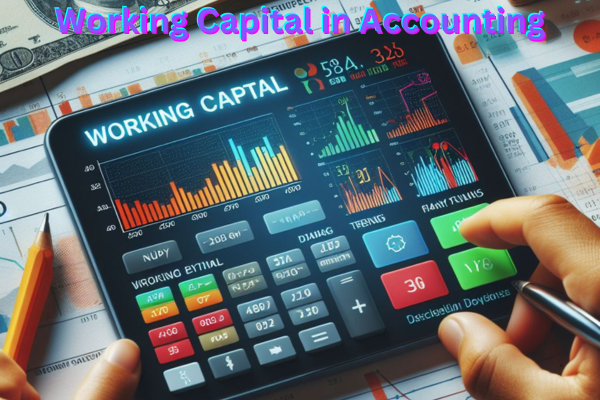Contents
Introduction of Working Capital in Accounting
In the realm of finance and accounting, the perception of the notion of working capital is fundamental. This economic metric holds the key to a company’s operational effectiveness and momentary monetary health. In this complete guide, we will embark on an experience to demystify working capital, unraveling its importance and how it intricately weaves into the cloth of accounting practices.
It’s About Time for You To learn How to Make $10,000+ Per Month in 90 Days or Even Less! Click here!!
Working Capital in Accounting Demystified
1. Defining Working Capital:
At its core, working capital represents the operational liquidity of a business. It is the distinction between a company’s present-day property and modern-day liabilities. Current belongings consist of cash, debts receivable, and inventory, whilst cutting-edge liabilities contain momentary money owed and payables.
2. Formula for Working Capital:
The working capital component is simple — it is the subtraction of modern-day liabilities from contemporary assets. This dynamic numerical fee offers a photo of a company’s capability to cover its momentary obligations.
3. Significance of Positive and Negative Working Capital:
A high-quality working capital implies that a business enterprise can without problems cover its momentary liabilities, fostering stability. Conversely, poor working capital indicators viable monetary stress, requiring a nearer appearance at money go with the flow management.
The Role of Working Capital in Accounting
1. Daily Operations and Working Capital:
Working capital is the lifeblood of everyday operations. It ensures that an enterprise can meet its operational needs, pay payments promptly, and catch possibilities as they arise.
2. Cash Flow Management:
A big factor of working capital is cash, which is crucial for assembling unexpected expenses, paying employees, and investing in growth. Accounting specialists meticulously song and control money flows to keep a wholesome working capital balance.
3. Inventory Management:
Inventory is a tremendous section of contemporary assets. Effective working capital administration entails optimizing stock ranges to forestall overstocking or stockouts, therefore affecting a company’s money position.
4. Accounts Receivable and Payable:
Invoices and repayments play a pivotal function in the working capital cycle. Accountants screen bills receivable to make sure of well-timed collection, whilst managing bills payable judiciously to preserve stability between paying providers quickly and keeping cash.
5. Financial Ratios and Working Capital:
Various monetary ratios, such as the present-day ratio and rapid ratio, leverage working capital aspects to provide insights into a company’s momentary economic health. Accountants make use of these ratios for complete monetary analysis.
It’s About Time for You To learn How to Make $10,000+ Per Month in 90 Days or Even Less! Click here!!
Working Capital in Accounting Management Strategies
1. Effective Cash Flow Forecasting:
Accountants appoint strong forecasting strategies to predict future money flows accurately. This proactive strategy aids in looking forward to working capital wishes and stopping money shortages.
2. Optimizing Inventory Levels:
Striking the proper stability between retaining sufficient stock to meet demand and keeping off extra inventory is a perpetual challenge. Accountants work on data-driven fashions to optimize stock levels, aligning them with commercial enterprise demands.
3. Negotiating Payment Terms:
Extending payables strategically and negotiating favorable phrases with suppliers can contribute notably to managing working capital. Accountants play a vital function in organizing and retaining these relationships.
4. Technological Solutions for Working Capital Management:
With developments in accounting technology, equipment, and software programs are now on hand to streamline working capital management. This equipment automates processes, decreasing the margin for error and supplying real-time insights.
It’s About Time for You To learn How to Make $10,000+ Per Month in 90 Days or Even Less! Click here!!
Conclusion
In conclusion, working capital is not simply a monetary metric; it is the heartbeat of a business’s monetary health. Its appropriate administration is a refined dance that accountants function daily, making sure a company’s capability to climate uncertainties and capture opportunities. As we’ve unraveled the layers of working capital and its necessary position in accounting, it turns evident that studying this notion is vital for guiding a commercial enterprise toward sustained success. Whether you are a budding entrepreneur or a pro accountant, recognizing the nuances of working capital is a ride well worth taking in the dynamic panorama of commercial enterprise and finance.

Leave a Reply